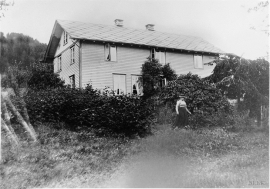- Remove Culture filter Culture
- Remove Dialects and arts filter Dialects and arts
- Remove Sveio filter Sveio
- Remove Granvin, frå 2020 del av nye Voss herad filter Granvin, frå 2020 del av nye Voss herad
- Remove Archaeology filter Archaeology
- Remove Kvam filter Kvam

Kjerland
On the farms Kjerland and Røynstrond, east of the river that flows into the fjord, we find many decorative painters who belong to the so-called sòlekistemålarane in Hardanger: Knut and Mikkjel Røynstrand and Johannes Jonsson Kjærland.


In Memory of Fartein Valen
“Fartein Valen is the key figure within newer Norwegian music. Not by way of being more popular than other younger composers, but because he aims at things higher, which he is fully confident of being able to reach since he commands all techniques. But there is a price to pay for reaching above the ordinary, and there is a price to pay for demanding more than the ordinary from the listeners. This is something Valen has experienced”.

Tjernagel
For almost three thousand years Tjernagelshaugen (the Tjernagel cairn) has lain as a landmark at the Bømlo fjord. The poet Torarin mentions the cairn in his account of Knut the Mighty, who in the year of 1028 sailed from Denmark to Nidaros: “And in front of the old cairn at Tjernagel sailed soldiers sharp with peace”.



Tangarås
From his loft window on the doctor’s farm at Tangarås the young Hans Ernst Kinck had a view of the fjord and the Mauranger mountains. The fjord settlements in West Norway made a strong impression on the young boy when his family moved from Setesdal, from “the stifling mystique of the ballad”, to Strandebarm in 1876. The new district doctor bought the old captain’s farm at Tangarås, which had for some time been a military head farm after Håbrekke further into the settlement.

Vangdal
At Salthamaren in Vangdalsberget it is thought that salt was burned some time in history, and deep layers of coal in the ground show that fire has been made up here several times. But they were hardly salt-burners, the first people who stopped here. Some of them carved figures into the rock. On top of the rocky outcrop, furthest out on the cliff, a group of Stone Age hunters carved animal figures. More than 1,500 years later Bronze Age farmers drew ship figures at the foot of the rock. Both these works of art - some of the oldest in Hordaland – are still visible, carved in the rock at Salthamaren.


